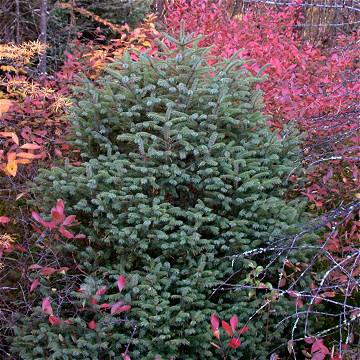

Picea mariana - (image 1 of 7)
Taxonomy
Family: Pinaceae
Habitat
Northern bogs, wetlands. Occasional on upland sites.
Associates
Often with Larix laricina or in mixed stands with with Abies balsamea, Betula papyrifera, Pinus banksiana, Pinus contorta, Picea glauca, Populus tremuloides.
Distribution
The northern half of MN, WI, MI, NY, through the New England states and the northern portion of western Canada and most of eastern Canada.
Morphology
Evergreen conifer to 70', more often 40' high and wide. Larger trees with drooping branches that turn upward at the ends; often a dwarfed on poorly-drained sites. Leaves straight, 8-15 MM long, blunt-tipped, dull gray-green, often glaucous, densely set along the twig; side needles at right angles, upper needles pointing forward. Cones ovoid, to 3cm long, purplish-brown, often massed on top of tree, persisting for many years. Root system shallow.
Notes
Flowers NA
Wetland indicator: Facultative Wetland
Red squirrels (Tamiasciurus hudsonicus) remove the tips of cone-bearing branches, which creates a dense upper crown with a section of bare trunk directly below it. Primary host of the parasitic plant Eastern Dwarf Mistletoe (Arceuthobium pusillum).
References
Dirr, Michael A. 1998. Manual of Woody Landscape Plants:
Their Identification, Ornamental Characteristics, Culture, Propagation and Uses.
5th ed. Champaign, Illinois: Stipes Publishing L.L.C.
Farrar, J. L. 1995. Trees of the Northern United States and Canada.
Ames, Iowa: Iowa State University Press.
Swink, F. and G. Wilhelm. 1994. Plants of the Chicago Region.
Indiana Academy of Science. The Morton Arboretum. Lisle, Illinois.
|
Michael Hough © 2005 |